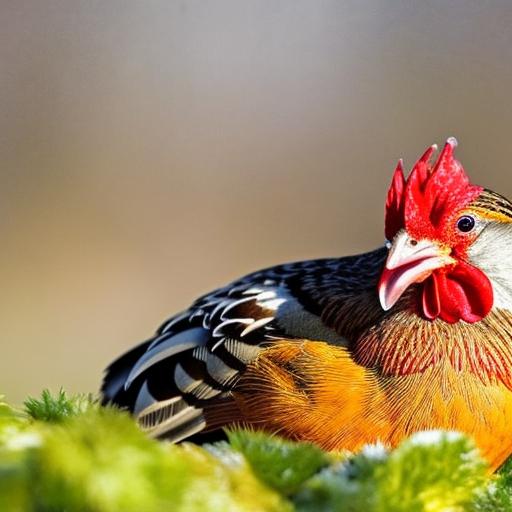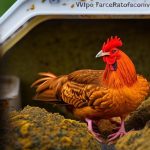Keeping chickens warm in winter is a crucial aspect of caring for these animals during the colder months. As temperatures drop, chickens are at risk of suffering from frostbite, hypothermia, and other cold-related illnesses. It is important for chicken owners to take the necessary steps to ensure their coop is well-insulated and that their chickens have adequate warmth and protection from the elements.
Key Takeaways
- Keeping chickens warm in winter is important for their health and egg production.
- Assessing your chicken coop’s insulation is crucial to determine if it needs improvement.
- Insulating your chicken coop can be done with materials like foam board, straw bales, and bubble wrap.
- Choosing the right bedding material, such as straw or wood shavings, can help keep chickens warm and dry.
- Adequate ventilation is necessary to prevent moisture buildup and ensure good air quality in the coop.
Why Keeping Chickens Warm in Winter is Important
Chickens need to be kept warm in winter for several reasons. First and foremost, chickens are susceptible to frostbite, especially on their combs, wattles, and feet. Frostbite occurs when the tissues freeze, leading to tissue damage and potential infection. By keeping the coop warm, chicken owners can prevent frostbite and its associated complications.
In addition to frostbite, chickens can also suffer from hypothermia if they are not kept warm enough. Hypothermia occurs when the body temperature drops below normal levels, leading to a range of symptoms including lethargy, loss of appetite, and even death. By providing adequate warmth in the coop, chicken owners can prevent hypothermia and keep their chickens healthy.
Assessing Your Chicken Coop’s Insulation
Assessing the insulation of your chicken coop is an important step in keeping your chickens warm in winter. Start by checking for any drafts or gaps in the walls or windows of the coop. These can let cold air in and warm air out, making it difficult for your chickens to stay warm.
Next, check the insulation of the walls and roof of the coop. Insulation helps to trap heat inside the coop and prevent it from escaping. If your coop lacks proper insulation, consider adding insulation panels or foam boards to improve its thermal efficiency.
It is also important to check the flooring of the coop. Cold floors can make it difficult for chickens to stay warm, so consider adding a layer of insulation or using deep litter bedding to provide additional warmth.
Insulating Your Chicken Coop: Tips and Techniques
There are several tips and techniques for insulating your chicken coop and keeping it warm in winter. One effective method is to use straw bales as insulation. Stack straw bales around the perimeter of the coop to create a barrier against the cold. This can help to keep the coop warmer and provide additional protection from drafts.
Another option is to use reflective insulation. Reflective insulation is made from a layer of foil or other reflective material that helps to reflect heat back into the coop. This can be particularly effective when used on the walls and roof of the coop.
Additionally, consider using weatherstripping to seal any gaps or cracks in the coop. Weatherstripping can be applied around doors, windows, and other openings to prevent drafts and keep warm air inside.
Choosing the Right Bedding Material for Your Chickens
Choosing the right bedding material for your chickens is important for keeping them warm in winter. The bedding material should provide insulation and absorb moisture, while also being comfortable for the chickens.
One popular option is straw bedding. Straw is a natural insulator and can help to keep the coop warm. It also absorbs moisture well, which is important for maintaining a dry environment in the coop.
Another option is wood shavings or chips. Wood bedding provides good insulation and absorbs moisture effectively. However, it can be more expensive than straw and may need to be replaced more frequently.
Providing Adequate Ventilation in Your Chicken Coop

While it is important to keep your chicken coop warm in winter, it is equally important to provide adequate ventilation. Ventilation helps to remove moisture, ammonia, and other gases from the coop, which can build up and cause respiratory problems for your chickens.
To provide adequate ventilation while still keeping the coop warm, consider installing vents or windows that can be opened and closed as needed. This allows for airflow when necessary, but can be closed during particularly cold or windy days.
It is also important to ensure that the ventilation openings are positioned in a way that prevents drafts. This can be achieved by angling the vents or using baffles to direct airflow away from the chickens.
Feeding Your Chickens for Winter
Feeding your chickens properly during winter is crucial for their health and well-being. In colder temperatures, chickens require more energy to stay warm, so it is important to provide them with a balanced and nutritious diet.
Include high-quality protein sources in their diet, such as mealworms or black soldier fly larvae, to help them maintain their body temperature. Additionally, provide them with plenty of fresh fruits and vegetables to ensure they are getting all the necessary vitamins and minerals.
Consider adding a supplement to their diet, such as poultry electrolytes or probiotics, to support their immune system and overall health during the colder months.
Watering Your Chickens in Winter
Ensuring your chickens have access to water during winter can be challenging, as water can freeze quickly in cold temperatures. However, it is important for chickens to stay hydrated, so it is crucial to find ways to keep their water from freezing.
One option is to use heated waterers or heated bases for your chicken’s water containers. These devices keep the water from freezing by providing a constant source of heat.
Another option is to use insulated water containers. These containers are designed to keep the water insulated and prevent it from freezing for longer periods of time.
Supplementing Heat in Your Chicken Coop
In some cases, supplementing heat in your chicken coop may be necessary to keep your chickens warm during extremely cold temperatures. This is particularly important for smaller coops or if you live in an area with harsh winters.
There are several options for supplementing heat in your chicken coop. One option is to use heat lamps or infrared bulbs. These can be hung in the coop to provide additional warmth. However, it is important to use caution when using heat lamps, as they can be a fire hazard if not used properly.
Another option is to use heated pads or mats. These can be placed on the floor of the coop to provide warmth from below. They are safe to use and can help to keep the coop warm without the risk of fire.
Conclusion and Additional Resources for Keeping Chickens Warm in Winter
Keeping chickens warm in winter is essential for their health and well-being. By assessing your chicken coop’s insulation, providing adequate bedding, ventilation, and feeding, and taking steps to prevent water from freezing, you can ensure that your chickens stay warm and healthy during the colder months.
For more information on keeping chickens warm in winter, there are several resources available. Books such as “The Chicken Health Handbook” by Gail Damerow and “Storey’s Guide to Raising Chickens” by Gail Damerow provide comprehensive information on all aspects of chicken care, including winter care.
Additionally, online forums and websites dedicated to chicken keeping can provide valuable insights and advice from experienced chicken owners. Websites such as BackyardChickens.com and TheHappyChickenCoop.com offer a wealth of information on all aspects of chicken care, including winter care.
By taking the necessary steps to keep your chickens warm in winter, you can ensure that they stay healthy and happy throughout the colder months.
If you’re looking for tips on keeping chickens warm in winter, you’ll definitely want to check out this informative article on chicken coop interior ideas from Poultry Wizard. They provide valuable insights and practical suggestions on how to create a cozy and insulated environment for your feathered friends during the colder months. From proper ventilation to using heat lamps and insulation, this article covers it all. Don’t miss out on this helpful resource, click here to read more: https://poultrywizard.com/keeping-chickens/chicken-coop-interior-ideas/.
FAQs
What temperature range is safe for chickens in winter?
Chickens can tolerate temperatures as low as 20°F, but it is recommended to keep their coop between 32°F and 50°F.
How can I keep my chicken coop warm in winter?
You can keep your chicken coop warm in winter by insulating the walls and roof, using a heat lamp or ceramic heater, providing plenty of bedding, and sealing any drafts.
What kind of bedding should I use to keep my chickens warm in winter?
Straw, hay, or pine shavings are good choices for bedding to keep chickens warm in winter. Avoid using materials that retain moisture, such as newspaper or sawdust.
Do I need to provide extra food and water for my chickens in winter?
Yes, you should provide extra food and water for your chickens in winter. They need more energy to stay warm, so make sure they have access to high-quality feed and fresh, unfrozen water.
Can I use a space heater to keep my chicken coop warm in winter?
It is not recommended to use a space heater in a chicken coop, as it can be a fire hazard. Instead, use a heat lamp or ceramic heater designed for use in a coop.
What are the signs that my chickens are too cold in winter?
Signs that your chickens are too cold in winter include huddling together, lethargy, and a decrease in egg production. If you notice these signs, take steps to warm up their coop.
Meet Walter, the feathered-friend fanatic of Florida! Nestled in the sunshine state, Walter struts through life with his feathered companions, clucking his way to happiness. With a coop that’s fancier than a five-star hotel, he’s the Don Juan of the chicken world. When he’s not teaching his hens to do the cha-cha, you’ll find him in a heated debate with his prized rooster, Sir Clucks-a-Lot. Walter’s poultry passion is no yolk; he’s the sunny-side-up guy you never knew you needed in your flock of friends!







